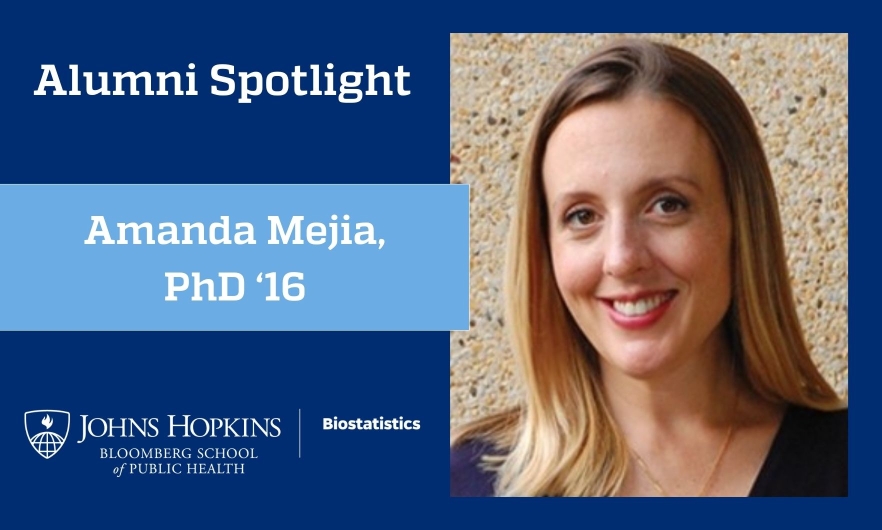Amanda Mejia, PhD '16
Amanda Mejia, PhD '16, is an Assistant Professor in the Department of Statistics and a member of the Program in Neuroscience at Indiana University.

Amanda Mejia is an Assistant Professor in the Department of Statistics and a member of the Program in Neuroscience at Indiana University. Her primary research interest is on the development of statistical methods for neuroimaging data, with a focus on functional magnetic resonance imaging.
Amanda obtained her PhD in 2016, where she was co-advised by Martin Lindquist and Brian Caffo.
How did you become interested in the field of biostatistics? What was your background before enrolling at Hopkins?
I am an engineer by training, so I have always loved solving problems, but I also wanted to make a positive impact on society in some way. During my Masters studies in industrial engineering, I became very interested in both data analytics and public health. It quickly became clear to me that biostatistics was the perfect meeting of these two, so applied to PhD programs and have never looked back.
How did Johns Hopkins Biostatistics prepare you for your career? What aspects of the program did you find most useful?
Hopkins Biostatistics trained me to be a statistician while remaining focused on the end goal of solving problems and contributing to science. As a student, you work directly with scientific collaborators, attend conferences, meet with seminar speakers, etc. That kind of experience is important for becoming an independent researcher, academic or otherwise.
What are your favorite memories of your time at Johns Hopkins Biostatistics?
The department does so much as a community, and that includes students. It’s hard to imagine a more inclusive and social academic environment. From the weekly tea time and impromptu coffee breaks, to events like the chili party, holiday party, cultural mixer and departmental retreat, to thesis defense celebrations, there are so many opportunities to come together, have fun, and connect with each other.
What advice would you give to prospective students?
In choosing a graduate program and later identifying an area of research, it’s important both to enjoy your work and to feel part of a supportive community. Try to explore a few areas before deciding where to settle down.
Describe your current position and responsibilities in a way that will inform prospective students about career opportunities in Biostatistics.
As an assistant professor in a department of statistics, my primary focus is methodological research and teaching. I teach one class per semester, so roughly one-quarter to one-third of my time each week is spent on teaching activities. What I love about being an academic working in biostatistics is the impact and the independence – you choose your research topics and get to work on problems that contribute to science and health. I also travel regularly for conferences, workshops, seminars and hackathons, and I enjoy connecting with the greater research community in that way. My research is at the interface of statistics and neuroimaging, so I get to interact with different scientific communities.
Can you describe your day-to-day life?
It always starts with coffee, then I try to spend most of my mornings writing or otherwise working on research. Two days per week, I spend the afternoon doing teaching activities. The other three days, I meet with collaborators by Skype, attend seminars on campus, meet with students, respond to emails, etc. I usually walk to and from work --one of my favorite things about living in a college town.
What has been your most satisfying job experience using your biostatistics background?
It’s rewarding to feel like I bring a valuable perspective to scientists working in neuroimaging. A lot of the methods I’ve worked on, such as shrinkage or outlier detection, are somewhat generalizable, so it’s exciting when someone learns about them and wants to try them on a new type of data. That’s how a lot of my collaborations have begun.
What about your experience at Hopkins that would be useful for prospective students and/or helping current students? This can include your experience in Baltimore.
Baltimore is a great place to live in a lot of ways – you’re surrounded by people who are open and friendly, a lot of whom are connected to the healthcare industry in some way. I lived in DC for the first couple of years and enjoyed the city, but Baltimore has a great community vibe, and I really liked living there.
Please list any notable accomplishments that you would like us to highlight.
My recent publications include papers in Biostatistics, NeuroImage and Annals of Applied Statistics, and this year I'm giving invited talks at ENAR, JSM, Statistics in Imaging, the Indiana Neuroimaging Symposium, and at seminars in several departments. While research is my passion, the opportunity to connect with students through teaching and mentorship has proven very rewarding. One of my life science students from last semester kindly commented, “Professor Mejia is the first professor I've really got to know and has actually shown real concern for a student. She is very understanding, relatable, and a very grounded person. Talking to her, I felt more comfortable about the course and made significant improvement. She really cares about her students.” Having a positive impact on students and their relationship with statistics is something I’ve come to truly value.
